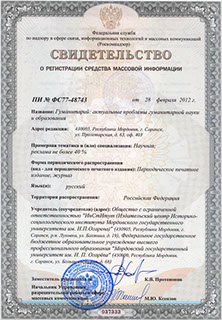ГуманитариЙ актуальные проблемы гуманитарной науки и образования
Russian Journal of the Humanities
ISSN 2078-9823 (Print)
ISSN 2587-7879 (Online)
Navigation
ISSN 2078-9823 (Print), ISSN 2587-7879 (Online)
DOI: 10.15507/2078-9823.048.019.201904.406-413
Ekaterina A. Averyanova
Research Institute of Humanities under the government of the Republic of Mordovia
(Saransk, Russia),
e-mail: averyanova-morm@mail.ru
Komsomol and the School in Mordovia in 1953–1964
Introduction. The issue of youth education has always attracted general attention. In this regard, the experience of the Soviet era is curious. Under the prevailing criteria of this period, as the time of totalitarian domination and ideology, it attracts attention and is interesting for research. The subject of this study was the period of the Khrushchev thaw, when significant changes to the Stalin reform were carried out, including the work of the Komsomol at school. This article discusses the process of educating communist youth in the republican schools during the transition from universal seven-year education to the creation of conditions for the transition to universal secondary education through involvement in labor and socially active activities. Materials and Methods. For solving the set of the research tasks, archival materials, statistical data, and also scientific literature were used. The study was conducted on the principle of historicism, objectivity and systematic. The statistical method was used in data processing. Results. Based on a study of archival sources, as well as available scientific literature, the main problems were identified, and the activities of the Komsomol in schools during the Khrushchev thaw were also considered. Against the backdrop of increased participation of the Komsomol in the educational environment, the processes of self-organization and effective activity of the Komsomol organization in schools are shown. Discussion and Conclusion. The Komsomol was ideologically and organizationally formed in the conditions of revolutionary upheavals caused by the Great Russian Revolution of 1917, the Civil War and the beginning of socialist construction. In a harsh atmosphere of mobilizing forces and resources for the implementation of Soviet modernization, the youth union was formed not only as a socio-political organization, but also as a state institution with a multifaceted structure for implementing youth policy and socializing the younger generation on communist ideas. The meanings inherent in the activities of the Komsomol were historically unique: universality, unitarity, ideologization, extreme centralism and hierarchical organizational structure. Not a single youth structure in the world, according to researchers dealing with this problem, has reached such a state, position and all-consuming orientation towards the implementation of its tasks.
Keywords: communist education, education of students, schools of Mordovia, Komsomol organizations, the Komsomol, the Komsomol of the Republic, student brigades, school circles, the activities of republican organizations of the Komsomol.
For citation: Averyanova E. A. Komsomol and the School of Mordovia in 1953–1964 // Gumanitarian : aktual’nye problemy gumanitarnoi nauki i obrazovaniia = Russian Journal of the Humanities. 2019; 19(4): 406–413. (In Russ.). DOI: 10.15507/2078-9823.048.019.201904.406

© Ogarev Mordovia State University. History and Sociology Institute, 2017
68, Of. 411, Bolshevistskaya St., 430005, The editorial office of the scholarly journal «Russian Journal of the Humanities»
Tel.: (8342) 24-25-90; 27-07-11, Fax: (8342) 24-25-90, E-mail: jurnal-econom-hist@isi.mrsu.ru
Designed by A. Napalkov, Email: napalkov@isi.mrsu.ru

